 The Internet! It’s stuffed full of evil kiddie fiddlers and dodgy geezers out to grab our children!
The Internet! It’s stuffed full of evil kiddie fiddlers and dodgy geezers out to grab our children!
Well, that’s what some aspects of the media would have us believe, but there’s no denying that there is an unsavoury side to the Internet, and that peer to peer file swapping networks have made it easier for paedophiles to share their filth.
Well, thank goodness for the crime-busting heroes at RazorPop who have released their new TrustyFiles 2.4 High Performance File Sharing, billed as the “peer-to-peer (P2P) file-sharing industry’s first child-pornography file-reporting solution”.
TrustyFiles claims to makes it easy for file-sharing users to report child pornography by simply clicking on a dodgy file and selecting the “Report Child Exploitation” command. This then fires off an anonymous report to P2P PATROL’s child-pornography lead processing resource [http://cphotline.org].
 TrustyFiles also keeps an eye on users’ Web habits, spawning a warning message when a user enters a search term known to be associated with child pornography.
TrustyFiles also keeps an eye on users’ Web habits, spawning a warning message when a user enters a search term known to be associated with child pornography.
“Razor who?” “Trusty what?” do we hear you say?
Well, that’s we thought too. They describe themselves as “the leading multi-network client with Kazaa, Gnutella, Gnutella2, and Bit Torrent search and download, as well as personal, private, and public file sharing” but we’ve never heard of them.
So we took a look at their Websites.
RazorPop’s homepage is a very weird affair, featuring a photograph of a woman in a doctor’s coat holding a CD aloft. A jagged line connects the picture to a woman unhappily holding a big picture of herself, which in turn connects to a guy frozen in an action pose trying to grab a CD. Most odd.
Suitably baffled, we clicked over to the TrustyFiles homepage, a garish affair festooned with glowing testimonials from conveniently anonymous customers – and some of those were a bit, well, strange.
Listen to what David V from who-knows-where has to say about the product, “If I’m posting this, it means my message has a real good meaning…its really easy to use ..I see why 100% users vote thumbs up”
Err, thanks for that, Dave.
5 star awards from obscure shareware sites are proudly plastered all over the homepage, although none of them were linked to the actual sites so we couldn’t check them.
So we looked up Trustyfiles on Usenet to see what people were people were saying about them. And the answer is: not a lot. Try as we might, we couldn’t find anyone even remotely as enthusiastic about the product as the mysterious David V.
By now you’ve probably worked out that we’re more than a little cynical about this release.
It’s not that we don’t feel that child pornography is a serious issue, but we’re concerned that companies who appear to be exaggerating and exploiting this issue for commercial leverage may encourage further legislation that will harm legal users.
We’ve never heard of RazorPop or the daftly-named ‘Trustyfiles’ software so, frankly, whatever they do isn’t going to make a tot of difference to the surfing habits of the Web world.
Now, we’re not saying that they’re not an honestly committed company, but we’re less than convinced about this product, and their unconvincing Websites don’t help their cause.
Without an industry-wide initiative, we don’t see the point in releasing restrictive P2P software that is unlikely to make users switch from far better-known programs, particularly when it’s hard to find much enthusiasm for the Trustyfiles product.
http://RazorPop.com
http://TrustyFiles.com

 The details of the Cell processor chip designed to power
The details of the Cell processor chip designed to power  The Cell’s architecture is described as scalable from “small consumer devices to massive supercomputers” and when installed inside powerful computer servers, is expected to be capable of handling a breathtaking 16 trillion floating point operations, or calculations, every second. Phew!
The Cell’s architecture is described as scalable from “small consumer devices to massive supercomputers” and when installed inside powerful computer servers, is expected to be capable of handling a breathtaking 16 trillion floating point operations, or calculations, every second. Phew! We all know that Skype is great. There’s a real thrill in speaking to people all over the world and knowing its not costing you anything at all.
We all know that Skype is great. There’s a real thrill in speaking to people all over the world and knowing its not costing you anything at all.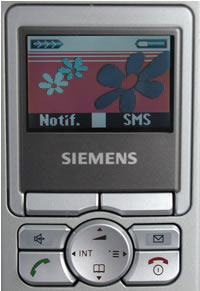 The Gigaset S440 is a handset fashioned more like a mobile phone. With a backlight colour screen and icons, it’s about the swankiest DECT handset we’ve seen. At 14cm (5.5-inches) tall, it sits comfortably in the hand.
The Gigaset S440 is a handset fashioned more like a mobile phone. With a backlight colour screen and icons, it’s about the swankiest DECT handset we’ve seen. At 14cm (5.5-inches) tall, it sits comfortably in the hand.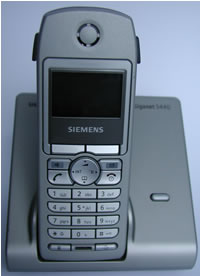 As mentioned, the Gigaset S440 is also a ‘normal’ phone and it retains this skill, giving you the ability to make both Skype and landline calls depending on your needs. Landline calls involve dialling as you would normally, and Skype takes a few steps more, which are detailed below.
As mentioned, the Gigaset S440 is also a ‘normal’ phone and it retains this skill, giving you the ability to make both Skype and landline calls depending on your needs. Landline calls involve dialling as you would normally, and Skype takes a few steps more, which are detailed below.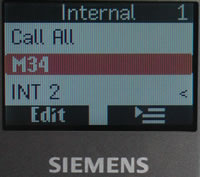 Enough of this background. How easy is it to use with Skype, I hear you call. Pretty simple.
Enough of this background. How easy is it to use with Skype, I hear you call. Pretty simple.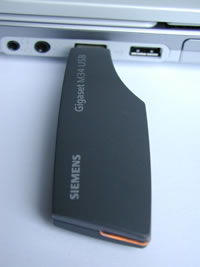 We found it becomes completely natural to use the S440/M34 combo. You really notice how restricted you are when you’ve got to call without it.
We found it becomes completely natural to use the S440/M34 combo. You really notice how restricted you are when you’ve got to call without it. The set-up needs to be done in the right order, but if you follow the instructions it will work without a problem.
The set-up needs to be done in the right order, but if you follow the instructions it will work without a problem.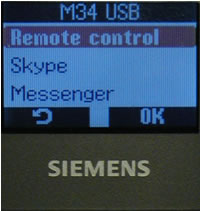 Instant Messenger via Skype, AOL or MSN. We tried this, but didn’t make a habit of it. It’s okay for very brief messages, but the restriction of the keyboard makes you itch to get back on the QWERTY.
Instant Messenger via Skype, AOL or MSN. We tried this, but didn’t make a habit of it. It’s okay for very brief messages, but the restriction of the keyboard makes you itch to get back on the QWERTY. The most successful gaming computer of the 80s is back – this time in a teensy weensy new ‘Direct to TV’ (D2TV™) unit.
The most successful gaming computer of the 80s is back – this time in a teensy weensy new ‘Direct to TV’ (D2TV™) unit. The DTV contains the classic games: Alleykat, California Games, Championship Wrestling, Cyberdyne Warrior, Cybernoid, Cybernoid II, Eliminator, Exolon, Firelord, Gateway to Apshai, Head the Ball, Impossible Mission, Impossible Mission 2, Jumpman Junior, Marauder, Maze Mania, Mission Impossibubble, Nebulus, Netherworld, Paradroid, Pitstop, Pitstop 2, Ranarama, Speedball, Summer Games, Super Cycle, Sword of Fargoal, Uridium, Winter Games and Zynaps.
The DTV contains the classic games: Alleykat, California Games, Championship Wrestling, Cyberdyne Warrior, Cybernoid, Cybernoid II, Eliminator, Exolon, Firelord, Gateway to Apshai, Head the Ball, Impossible Mission, Impossible Mission 2, Jumpman Junior, Marauder, Maze Mania, Mission Impossibubble, Nebulus, Netherworld, Paradroid, Pitstop, Pitstop 2, Ranarama, Speedball, Summer Games, Super Cycle, Sword of Fargoal, Uridium, Winter Games and Zynaps. Video streaming specialists,
Video streaming specialists,  The technology uses Forbidden’s ground breaking FORscene live compressor, that utilises advanced digital compression techniques to deliver a live video feed to PCs, Macs and laptops via the Web.
The technology uses Forbidden’s ground breaking FORscene live compressor, that utilises advanced digital compression techniques to deliver a live video feed to PCs, Macs and laptops via the Web. Games console maker
Games console maker  The same technology has also been employed by Nintendo to protect game demos that are issued on a trial basis for play in retail stores and other demo environments.
The same technology has also been employed by Nintendo to protect game demos that are issued on a trial basis for play in retail stores and other demo environments. The anticipation around the release of Gran Turismo 4 has been, to put it mildly, huge. Sony are hoping this Playstation2 only game will be their Halo2 type blockbuster.
The anticipation around the release of Gran Turismo 4 has been, to put it mildly, huge. Sony are hoping this Playstation2 only game will be their Halo2 type blockbuster. Skype today released their Voice over IP (VoIP) software for Linux and Macintosh.
Skype today released their Voice over IP (VoIP) software for Linux and Macintosh. Squeezed on both sides by ever-competitive satellite and cable providers, TiVo is trying to woo third party developers into creating compelling new add-on services for their product.
Squeezed on both sides by ever-competitive satellite and cable providers, TiVo is trying to woo third party developers into creating compelling new add-on services for their product.